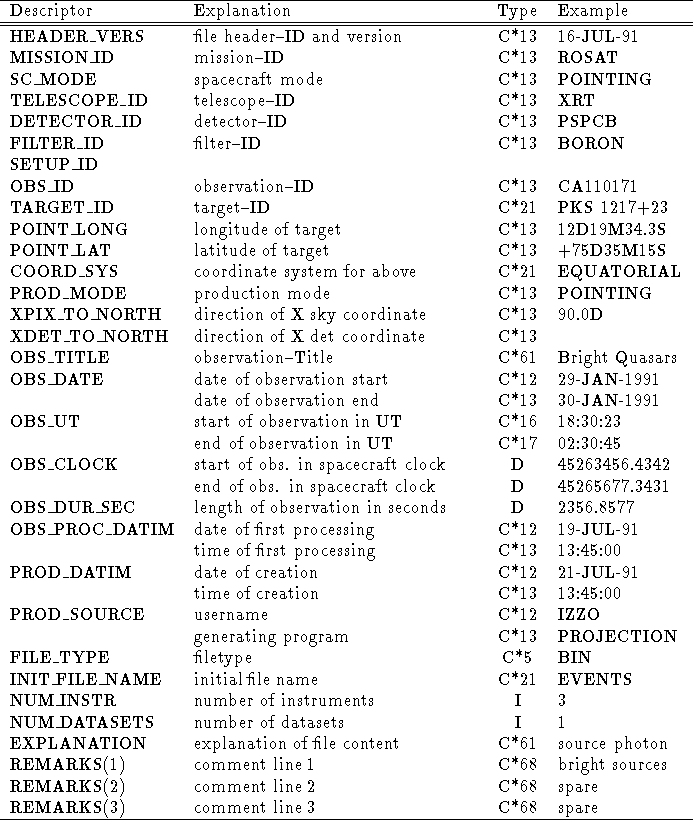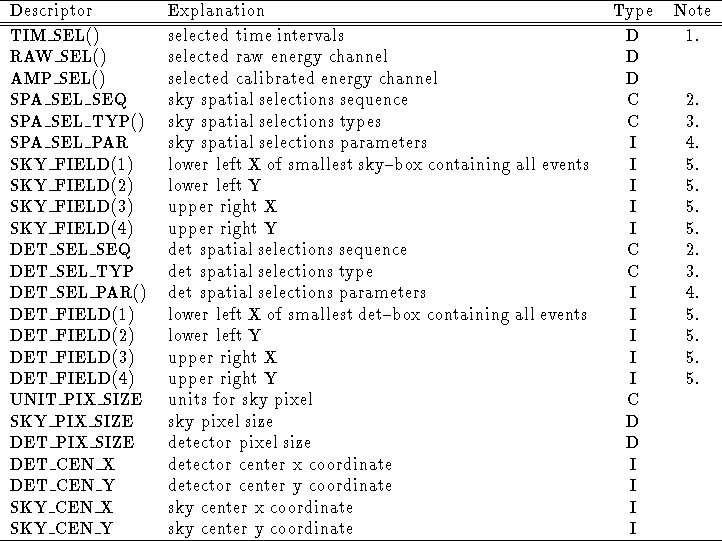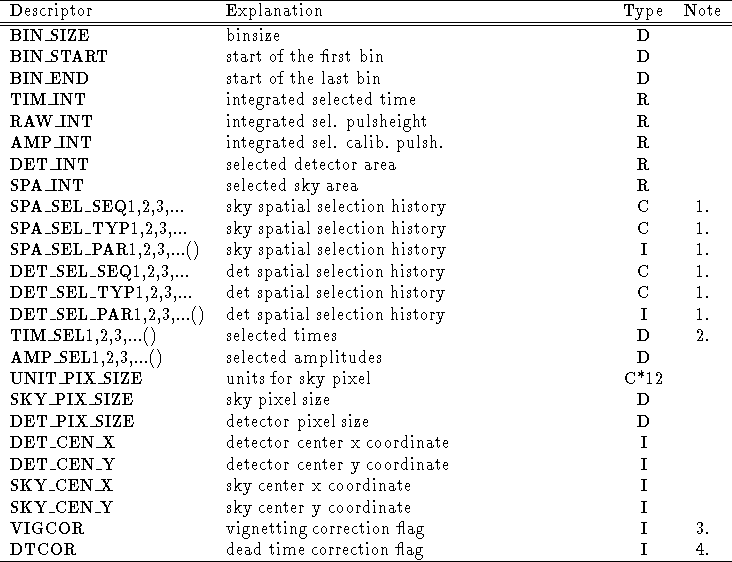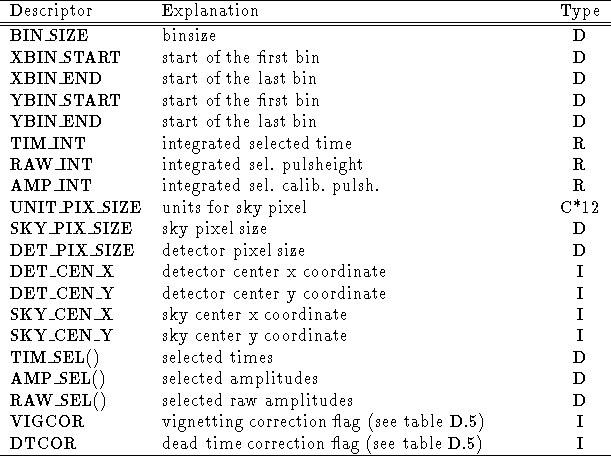




Next: ROD Files (PSPC)
Up: Appendices
Previous: MIDAS Standard Headers

Table C.1: EXSAS General Header

Table C.2: EXSAS Special Header for filetypes PET and PEM
Notes:
- The TIM_SEL descriptor
provides the selected time intervals for the photons listed in the PET.
Each time interval is defined by its start value
(odd positioned elements in the descriptor) followed by its end value,
expressed in the same units used for the TIME photon parameter.
The listed selected times are the result of the intersection
between the original (instrumental) accepted times and all the
time selections specified by the user on the photon list.
Up to 16384 selected time intervals may be stored in the descriptor.
A similar meaning have the RAW_SEL and AMP_SEL descriptors for
the selections in non-calibrated and calibrated photon amplitudes,
respectively.
- A history of different spatial selections cannot generally
be expressed in a simple form. Since no mask images are created
for the spatial selections, it is necessary to provide the information
as a sequence of elementary spatial selections performed
over the original photon event list.
In the character descriptor SPA_SEL_SEQ the presentation points
to the elementary spatial selections described explicitly
in the SPA_SEL_TYP and SPA_SEL_PAR descriptors. The
symbols + and : represent union
and intersect operations between the elementary spatial selection
applied to the data, while the symbol # is used as a field
delimiter between independent selection groups.
However, it is not necessary for the general user to understand the
meaning of the SPA_SEL_*** descriptors, because they are
automatically composed, written out, read and interpreted by the
appropriate Data Preparation tasks.
- This character descriptor, together with the SPA_SEL_PAR,
is used to describe all the elementary spatial selections composing
the selection sequence which brought to the photon list contained
in the PET. A letter ``B'' at position n indicates that the
n-th elementary selection is a BOX selection, a letter
``R'' indicates a RING selection, and a letter ``S'' indicates
a SECTOR selection.
- This descriptor, together with the SPA_SEL_TYP, is used
to describe all the elementary spatial selection composing the spatial
selection history which brought to the photon list contained in the PET.
The listed numbers must be taken in groups of 4 elements, each group
corresponding to one character in the SPA_SEL_TYP descriptor.
When the corresponding character is ``B'', the 4 elements of the group
represent the X,Y coordinates at the lower left and upper right corners
of the selected box.
When the corresponding character is ``R'', the 4 elements of the
group represent the central X,Y coordinates and the internal and
external radii of the selected ring.
When the corresponding character is ``S'', the 4 elements of the
group represent the vertex X,Y coordinates and the start-end
angles of the sector.
- Smallest box on the sky containing all the events belonging to the PET.
It is described by its lower left and upper right corner in sky
coordinates.
The descriptors associated to spatial selection operations,
SPA_SEL_SEQ, SPA_SEL_TYP,
SPA_SEL_PAR and SKY_FIELD,
refer all to selections of photons over their sky pixels positions.
Exactly the same meaning have the descriptors
DET_SEL_SEQ, DET_SEL_TYP, DET_SEL_PAR and DET_FIELD,
regarding to selections in detector pixels.

Table C.3: EXSAS Special Header Extension for filetype PEM
For PEM tables this extension is used in addition to table
C.2

Table C.4:
EXSAS Special Header Extension for filetype PET
when more than one photon list is present
Notes:
- A PET may contain more than 1
separate photon lists. The descriptor
NUM_DATASETS from the general EXSAS header
gives the number of independent photon lists contained in the PET.
The PET column labelled ID,
used for the identification of photons belonging to different lists,
will show integer values in the range 1, ..., NUM_DATASETS.
The descriptor START_DATASETS has NUM_DATASETS elements
and contains the table row numbers at which each of the independent
photon lists starts,
once the table was sorted according to the ID column.
Because the first photon list starts at the first table row,
it is always START_DATASETS(1) = 1.
The difference START_DATASETS(n+1) - START_DATASETS(n)
returns the number of photons belonging to the n-th independent list.
For the last independent photon list (n = NUM_DATASETS) the number
of photons is given by TBLCONTR(4) - START_DATASETS(n) + 1.
- Here the final exposure time, result of all the time-selections
applied to the data (including the instrumental accepted times),
is given for each of the NUM_DATASETS data sets included in the file.
Please, note that this exposure time is not dead time corrected.
Moreover, if the source of interest was not always kept inside
the detector, the exposure time is overestimated.
The calculation of the true exposure time is performed by
the correction task (in attitude mode)
where the descriptor TIM_INT is updated accordingly.
Similar meaning have the RAW_INT, AMP_INT and SPA_INT
descriptors for pulse height, calibrated pulse height
and spatial selections, respectively.
- The area of the selected spatial dominion is expressed in
sky pixel.
- The area of the selected spatial dominion is expressed in
detector pixel.

Table C.5: EXSAS Special Header for filetype BIN
Notes:
- The SPA_SEL_SEQ1,2,3,... SPA_SEL_TYP1,2,3,...
and SPA_SEL_PAR1,2,3,... parameters contain history of spatial
selections in sky pixels for each of the binned data sets in the table.
Their structure is identical to the structure of the corresponding
descriptors of the PEM and PET Headers.
- The TIM_SEL1, TIM_SEL2, etc., descriptors contain the accepted
times for each of the binned data sets in the table.
Their structure is identical to the structure of the TIM_SEL
descriptor of the PEM and PET. In case of a light curve the
single descriptor TIM_SEL is given in phase
(valid for all light curves included in the BIN table).
- If the VIGCOR descriptor is present, and set to 1, it means that
the current BIN table was created through Projection set in correction
mode. In order to ignore the correction on the data, just set this
descriptor value to 0, or delete the descriptor itself.
- If the DTCOR descriptor is present, and set to 1, it means that
the current BIN table was created through Projection set in correction
mode, and the dead time correction was also performed. In order to
ignore the dead time correction on the data, just set this
descriptor value to 0, or delete the descriptor itself.

Table C.6: EXSAS Special Header for images (filetype IMA)





Next: ROD Files (PSPC)
Up: Appendices
Previous: MIDAS Standard Headers
If you have problems/suggestions please send mail to
rosat_svc@mpe-garching.mpg.de






